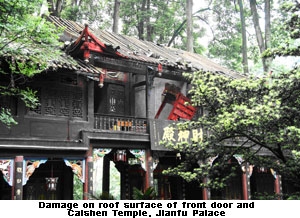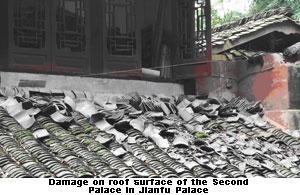| Post-earthquake Evaluation on World Cultural Heritage Site Mount Qingcheng and Dujiangyan Irrigation System |
| PublishDate:2009-02-20 Hits:4262 |
|
This research focus on the following aspects: Analysis on the Outstanding Universal Values of World Heritage Mt. Qingcheng and Dujiangyan, Disaster Damage Evaluation on the site, Loss in Value — the Earthquake’s Impact on the Outstanding Universal Values of the World Heritage, Post-disaster Management and Conservation Status of the site, Action Plan for Post-earthquake Conservation of the site. November 29th, 2000, the 24th Session of UNESCO World Heritage Committee decided to inscribe Mt. Qingcheng and Dujiangyan Irrigation System on the World Heritage List, meeting the Cultural criteria (ii),(iv), and (vi),adopted by the Operational Guidelines for the Implementation of World Heritage Sites. The advisory body evaluated the site as the following: a. Dujiangyan Irrigation System owns the originality in the world history of water conservancy and Mt. Qingcheng in Chinese Taoism; b. Dujiangyan Irrigation System is crystallization of human civilization, uniquely seen in the history of world science and technology; c. Mt. Qingcheng is the birthplace of Chinese Taoism, the ancestral mountain and court hall of the Tanshi Tao; d. Mt. Qingcheng and the Dujiangyan Irrigation System are epoch-making masterpieces of Chinese national culture, exerting great influence to later generations. The heritage components of Mt. Qingcheng include the important historical buildings or relics in the core area. Among them, there are seven Taoist buildings ¬- Jianfu Palace, Tianshi Celestial Cave, Shangqing Palace, Yuanming Palace, Yuqing Palace, Zushi Palace and Chaoyang Cave. Some stone carves and sculptures are also closely related with the Taoist culture. Besides there is one cultural relic: Hui-qing-jian-fu Palace. The heritage components of the Dujiangyan Irrigation System mainly include hydraulic structures of the headwork, historical buildings, ancient sites and relics in the core area. Hydraulic structures of headwork consist of three main works (the Yuzui Bypass Dike, the Feishayan Floodgate, and the Baopingkou Diversion Passage) and some auxiliary works such as the Baizhang Dike or the V-Shaped Dike. The historical buildings include: Erwang Temple, Anlan Suspension Bridge and Yulei Pass. Ancient sites and relics are: Lidui (including Fulong Temple), Fengqiwo (buried iron) and Douxi Terrace. After the Sichuan Earthquake in May 12th, 2008, the sites of Mt. Qingcheng and Dujiangyan Irrigation System were seriously damaged. According to the statistics, many historical buildings in the core area were damaged to various degrees, such as the Fulong Palace, Chenghuang Temple, Ten Palace, Jianfu Palace, Yianshi Celestial Palace and Shangqing Palace. The infrastructures on the heritage sites, such as bridges, pavilions, roads and signs and boards on tour routes, suffered considerable damage. This report analyzes and evaluates the damage inflicted on Mt. Qingcheng and Dujiangyan Irrigation System respectively, focusing on their heritage components and general environment. According to the severity of damage, this report grades the buildings and the ancillary work into three classes: A. Totally collapsed B. Partly collapsed, inherent danger of subsequent damage (the structure is tilted and the walls are badly cracked) C. Partly damaged On the analyze of the value – loss of the site, the report focus on the following aspects: the earthquake’s impact on the authenticity and integrity of the heritage site; the Earthquake’s impact on the great scientific and technologic achievements in ancient China, such as the Dujiangyan Irrigation System; the Earthquake’s impact on Taoist culture on Mount Qingcheng. After the earthquake, the local government took a series of actions to protect Mt. Qingcheng and Dujiangyan. Up to the end of 2008 most historic buildings finished the repair and restoration work under the guidance of experts. Some further restoration of the important historic monuments was on the process with the social financial support. The Er’wang Temple and Fulong Temple, which were seriously damaged during the earthquake was undergoing major integral repair. The report concludes the actions based on the on-site investigation and the inquiry from different departments. Finally the repot gave the proposal on the action plan separately related to potential natural threats and to potential threats caused by human interventions in the process of conservation and reconstruction. Provided by Yanhua Zhang, Director of Research Unit, WHITR-AP (Shanghai) |
- News | WHITRAP Shanghai and CNR-ISPC bilateral meeting
- News | WHITRAP meets Cité de l’Architecture et du Patrimoine
- WHITRAP Hosting "Workshop on Preliminary Assessment for National Focal Points of the Asia Region" in Chengdu
- WHITRAP Shanghai meets UNESCO
- INTERNATIONAL CONFERENCE PRELIMINARY ANNOUNCEMENT & CALL FOR PAPERS
- Observation of the 46th Session of the World Heritage Committee
Copyright © 2009-2012 World Heritage Institute of Training and Research-Asia and Pacific (shanghai)




